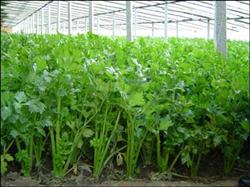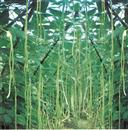How to solve the high temperature barrier of greenhouse cucumber?

For cucumber cultivated in greenhouse, with the gradual increase of air temperature in April, if the ventilation is not timely or the ventilation is not smooth, the temperature in the greenhouse can sometimes be as high as 40 ~ 50 ℃, sometimes it can be as high as 50 ℃ in the afternoon, which causes damage to the growth and development of cucumber, the leaflet wilting of light plant stops growing, and the whole leaf wilts of heavy plant, which has a great influence on the yield and quality of cucumber. When there is high temperature in the seedling stage, the seedlings grow too much, the cotyledons are small, drooping, and sometimes flowers top. In the seedling stage, there are high temperature, light leaf color, large and thin leaves, not stretching, elongated internodes or overgrown. When the plant was damaged in the adult stage, the chlorotic spots of 1 mm ~ 2 mm appeared on the leaves at first, and then expanded gradually. after 3 ~ 4 days, the mesophyll and veins of the whole leaf turned yellowish green from top to bottom, and the disease in the upper part of the plant was serious, and the plant stopped growing in severe cases. When the temperature in the greenhouse reaches 48 ℃, it will lead to the wilting and blackening of the leaflets near the growing point of cucumber in a short time. When the time is long, the leaves of the whole plant wilt, such as hot water. In terms of prevention and control, strengthen ventilation. Cucumbers have their right temperatures at all stages. When raising seedlings, the temperature in the bed should be kept at 25: 30 ℃ during the day and 16: 18 ℃ at night. After 80% of the seedlings were unearthed, the temperature should be reduced in time, 20: 25 ℃ during the day and 14: 16 ℃ at night. After planting, the temperature reached 30: 35 ℃ in daytime and no less than 18: 16 ℃ at night in slow seedling stage. After slowing down the seedlings, the room temperature reached about 30 ℃ in daytime and 16-14 ℃ at night. During the melon-bearing period, the greenhouse temperature was kept at 28: 30 ℃ during the day, 16: 18 ℃ at night, and the relative humidity was less than 85%. In production, you should look at the thermometer at any time to grasp the temperature changes, and when the temperature is slightly higher, it should be ventilated and cooled through the doors and vents of the greenhouse. If the temperature remains high, the bottom of the south side should be opened to make the temperature of the shed drop down. At the same time, you should pay attention to watering, preferably at 8: 10 in the morning. Do not water at night or on cloudy days. At the same time, pay attention to the difference between water temperature and ground temperature under 5 ℃. The relative humidity in the suitable growth period of cucumber is about 85%. The relative humidity of the greenhouse should be ventilated and reduced when the relative humidity is higher than 85%. When the evening temperature is 18-20 ℃, ventilation for 1 hour can reduce the humidity at night, prevent "excessive growth" and avoid high temperature obstacles. Due to the high temperature, resulting in plant overgrowth, in production can promote the plant to inhibit its overgrowth, so as not to form a situation of overgrowth. For this reason, it can be sprayed or dipped in flowers with 100-fold liquid of Baoguoling hormone, which can promote early ripening and increase production and prevent overgrowth. Appropriate application of phosphorus and potassium fertilizer, or spraying multi-component organic active liquid fertilizer or 0.2% solution of potassium dihydrogen phosphate or 0.1% urea solution as extra-root topdressing for 2 times can effectively improve the heat resistance of the plant. In case of continuous high temperature or atmospheric drought, cucumber in greenhouse has large evaporation and exuberant respiration, which consumes a lot of water, and wilting occurs for a long time. At this time, it is necessary to appropriately increase the number of watering, watering thoroughly, and watering again every two days to make the seedlings fully absorb enough water. How to correct the abnormal appearance of cucumber in protected area? 1. Internode and petiole are too long. It is mainly caused by high temperature and high humidity. Properly control water and fertilizer, increase ventilation, reduce humidity and temperature. two。 The leaves wilted. During the fruit expansion period, the lower leaves wilt, and the older the leaves are, the earlier they wilt. It is mainly caused by lack of water. In the peak melon period, we must maintain an adequate supply of water, and properly plough and loosen the soil. 3. The plant is short, the leaves are yellowish green, the leaves are small and thin, the lower leaves are aging, and the leaves fall early. It is mainly caused by the deficiency of nitrogen, the decrease of chlorophyll content and the deficiency of photosynthesis products. Corrective measures should be carried out immediately on the basis of applying sufficient base fertilizer. According to the principle of a small number of times, the amount and times of topdressing should be increased appropriately. 4. The leaves are dark green and the leaves are thickened. It is mainly caused by the accumulation of photosynthates in the leaves at night, especially after sunset, when the temperature is too low to transport the photosynthates produced during the day. Corrective measures: increase room temperature and strengthen night heat preservation measures. 5. The plant is dwarfed, the Internode is short, especially near the tip, the young leaves are small, and the leaves are curled upward. In severe cases, these leaves dry up from the edge to the inside. Main reason: due to the high acidity of the soil (pH
- Prev

Control of Bean Diseases in Greenhouse
1. Symptoms of bean rust: mainly harmful to leaves, but also harmful to petioles and pods when it is serious. At the beginning of the disease, the back of the leaves produced pale yellow spots, then rust brown, raised small pus scar shape, then expanded into summer spore pile, epidermis rupture after the emission of reddish-brown powder. That is, urediospores. Second, bean powdery mildew...
- Next

How to prevent pumpkin spot disease
Cucurbita mottle mainly affects leaves and flower axes. The pathogen overwinters in the soil with the diseased body. In spring, the pathogen spread by rain sputtering, and the leaf spots were round to nearly round or amorphous in the early stage of the disease. The leaf margin is black brown, the junction of disease and health is moist, when the humidity is high, the spot surface is densely populated with small black spots, and the serious leaf spot is fused, causing the leaf bureau to be wet.
Related
- Where is it suitable to grow horseradish in China? it is expected to see the middle altitude horseradish in Alishan.
- How to prevent tomato virus disease reasonably? (Control methods included)
- Many people like to plant towel gourd on the balcony. What are the main points of this method and management?
- What crops can chili peppers be mixed with?
- Fertilization techniques and matters needing attention in Tomato
- What are the grafting techniques for peach seedlings in spring?
- Harm and control methods of root swelling disease of Chinese cabbage
- What are the pests of sweet potatoes? How to prevent and cure it?
- Symptoms, causes and Control methods of navel Rot in Tomato
- The cause of "Cucumber rotten bibcock" in Farmers' planting Cucumber and its Control Plan

